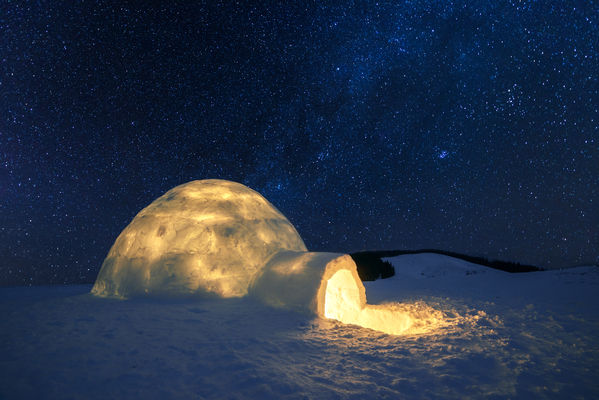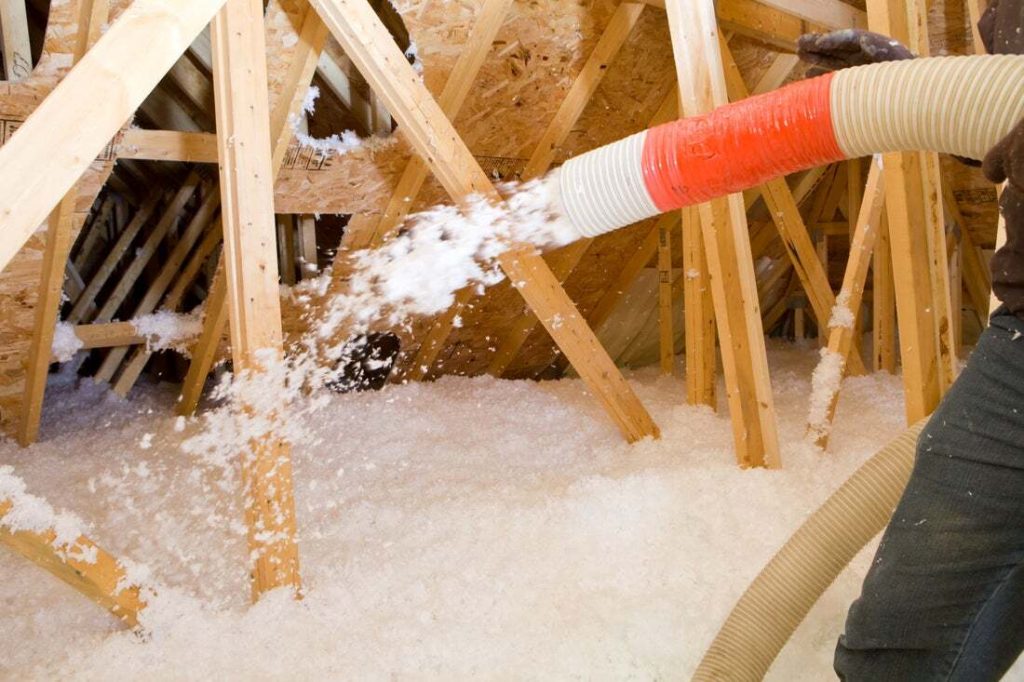Staying comfortable at home has more in common with igloo science than you might think.
Perhaps you recently built an igloo with your family after a winter storm, and you found it surprisingly warmer than you expected.
Or maybe you watched a documentary about indigenous people who live in the snow, and you’re left wondering: How in the world does an igloo stay warm inside?
It’s a fair question. How can a little house of snow and ice make you feel warmer? (And what does that have to do with how your own house stays warm, if anything?)
If your sheer curiosity or internet search has led you here, you’ve found the right place.
The short answer to this puzzling question of How do igloos stay warm? is insulation.
But let’s dig in.
- How warm is an igloo inside?
- Why are igloos warm?
- Why does insulation, even when made of snow and ice, trap in heat?
- Does your house have enough insulation to keep you warm—or is it igloo-cold?
- How to warm up your house with high-performance insulation at no upfront cost
Hi, we’re Sealed! We’re home energy experts that specialize in how high-performance insulation, air sealing, and HVAC work together to make your home comfortable, healthy, and energy efficient in every season.

How warm is an igloo inside?
An igloo could be up to 40 to 60 degrees warmer than the outside area (1, 2).
Overall, the warmth inside an igloo will depend on a few things, including:
- Outside climate
- Thickness of the igloo walls
- Body temperatures of the people inside
In general, igloos are able to stay warm and comfortable even when the outside temperature is well below freezing. But how?
And what can we learn from igloos about staying comfortable—and conserving heat energy—in our modern-day homes?
Why are igloos warm?
Here’s how they do it: Igloos work by blocking cold winds while preserving heat generated by your own body temperature.
The insulation provided by densely packed snow and ice stops your body’s natural heat from escaping right out into the atmosphere—keeping it inside the igloo itself.
It’s pretty incredible that your own metabolic processes act as the heating system for the igloo itself. (Too bad we can’t heat our entire homes comfortably with our own body heat, right?)
And if you add in a properly vented fire, well, you can make an igloo even warmer.
Our take? Igloos are truly a genius cold-weather housing solution designed by early humans.
But tried-and-true building science principles are in play in the simple igloo design, and many of the same principles that trap heat within the snowy walls of an igloo are at work in your house today.
Tried-and-true building science principles are in play in the simple igloo design.
In fact, your home’s insulation works in a similar way to the walls of an igloo.
The only difference (other than it’s unlikely your house is insulated with snow) is that modern insulation is there to trap in paid-for heating and cooling produced by an HVAC system—while also doing the work of keeping outside temperatures out.
Your whole home (thankfully!) doesn’t have to rely on trapping in your natural body heat to keep you warm.
Check out the video below for a quick visual of how home weatherization, including insulation and air sealing, works to keep outside air out and inside air (aka, heat in winter) indoors.
Curious if you qualify for powerful insulation upgrades at no upfront cost with Sealed? See if you qualify.
Why does insulation—even when made of snow and ice—trap in heat?
Insulation (yes, even the igloo kind made of snow) traps in heat by stopping the flow of air molecules. This trapped air creates a barrier that slows down the transfer of heat, which helps to keep the heat inside a home or building in the winter and out in the summer.
This barrier, also called a thermal boundary, essentially acts as the dividing line between the indoors and the outdoors.
In your home, air sealing and insulation work together to create a separation that keeps outdoor temperatures, moisture, and allergens outside of your house and seals in your paid-for heating and cooling.
You could cut up to 45% of the energy you use to heat and cool your house by air sealing the ceiling and floors (and walls in some cases).
2022 Insulation Industry Opportunity Study
And in an igloo, densely packed bricks of snow form a thick layer of insulation that trap in body heat, creating a separate, warmer temperature inside the snowy dome.
And when the ice blocks melt and refreeze? The fresh layer of ice stops cracks, open air bubbles, and seams in the igloo walls from taking in outside air. And that’s how air sealing works in an igloo.
Does your house have enough insulation to keep you warm? Or does it feel like an igloo?
While igloos can keep people warmer in colder temperatures, your home shouldn’t feel like one.
But many houses do feel like igloos in the winter… because 90% of U.S. homes are under insulated (3).
While igloos can keep people warmer in colder temperatures, your home shouldn’t feel like one.
The amount of insulation your house needs to keep you comfortable and use your heating and cooling systems efficiently depends on a few things, including:
- Your local climate
- The area of the house that needs improved insulation (your attic versus your exterior walls, for example)
There are a variety of insulation materials used in houses, like treated natural wool, treated recycled paper or cardboard, spray foam, fiberglass, mineral wool, or foam board.
90% of U.S. homes are under insulated. Learn how to get insulation upgrades at no upfront cost.

Every house is unique and often requires a combination of insulation materials to solve energy waste and comfort issues.
For example, a house with a large attic and a garage attached to a living area might benefit from a combination of cellulose insulation in the attached garage walls and spray foam insulation in the attic.
Ultimately, houses aren’t supposed to be drafty and uncomfortable, no matter what year they were built. And yes, you can make a cold house warmer for good.
That’s where insulation comes to the rescue—right along with air sealing, which is the process of closing up all the open gaps, seams, and holes where air escapes in your house and is usually completed with insulation upgrades. Learn how to find air leaks in your house in our troubleshooting guide.
Air sealing and insulation upgrades work together to keep you comfortable and increase the efficiency and lifespan of your HVAC system.
Air sealing and insulation upgrades work together to repair your house’s thermal boundary. And they help your existing heating and cooling systems work better and last longer.
But permanently fixing your house’s insulation issues is a little more complex than making an igloo in the backyard, and it’s best to have a home performance contractor assess what your house might need.
How to get high-performance insulation at no upfront cost
Igloos are incredibly cool in how they keep you warm, but remember, your house shouldn’t feel like you’re living outdoors on a cold winter day.
If you’re ready to feel warmer in the winter and cooler in the summer—all while using less energy—it’s time to talk to Sealed.
If your house qualifies to work with Sealed, we’ll help create a customized plan to solve your house’s energy waste and comfort issues for good with high performance insulation, air sealing, and heat pump HVAC upgrades. (You get the upgrades you need—and nothing you don’t.)
We and stand by our work. And you pay for the work done with a flexible payment option that works best for you and your budget.
Sounds too good to be true? It’s not! Learn more about the Sealed payment plan.
Ready to get started? Tap Here to see if your house qualifies.